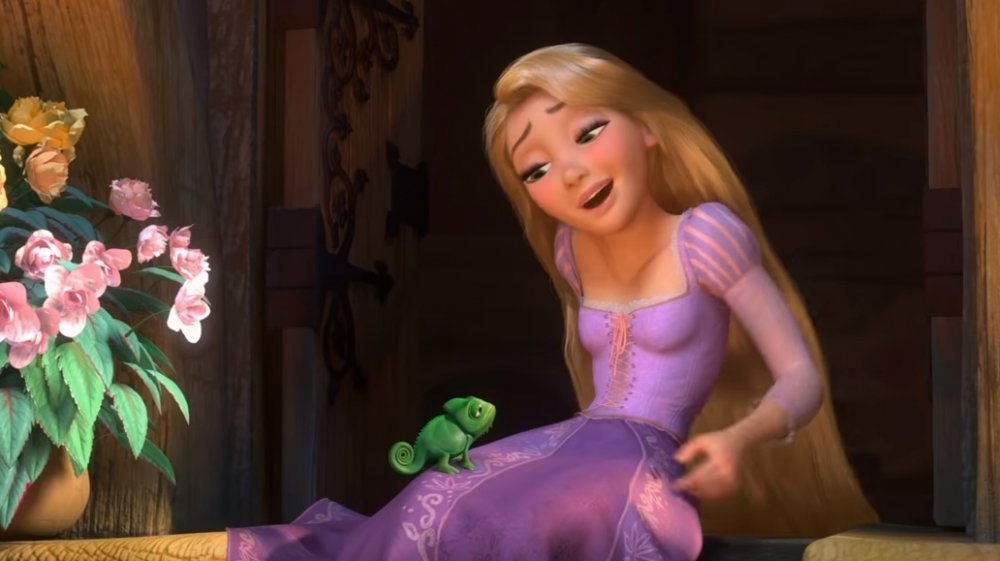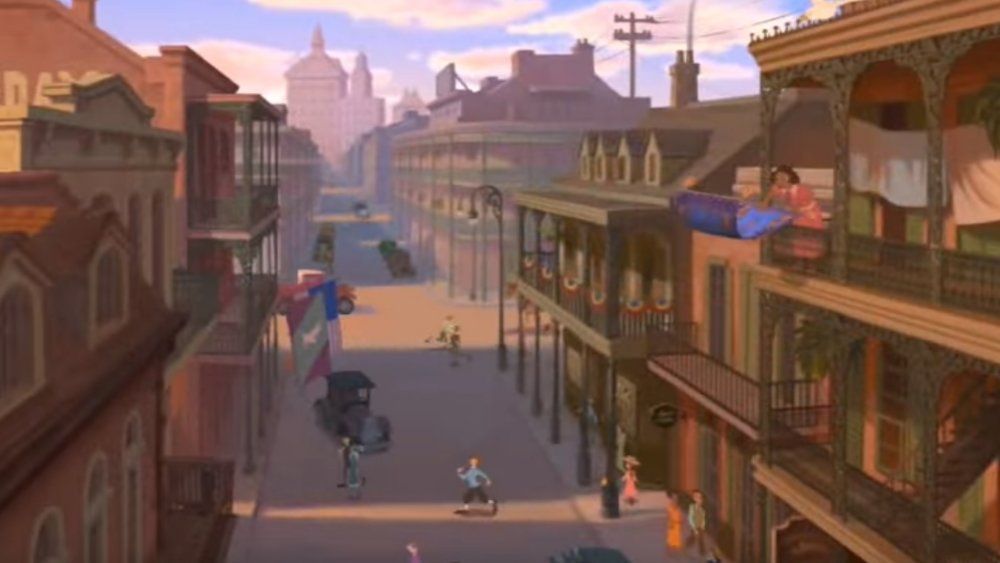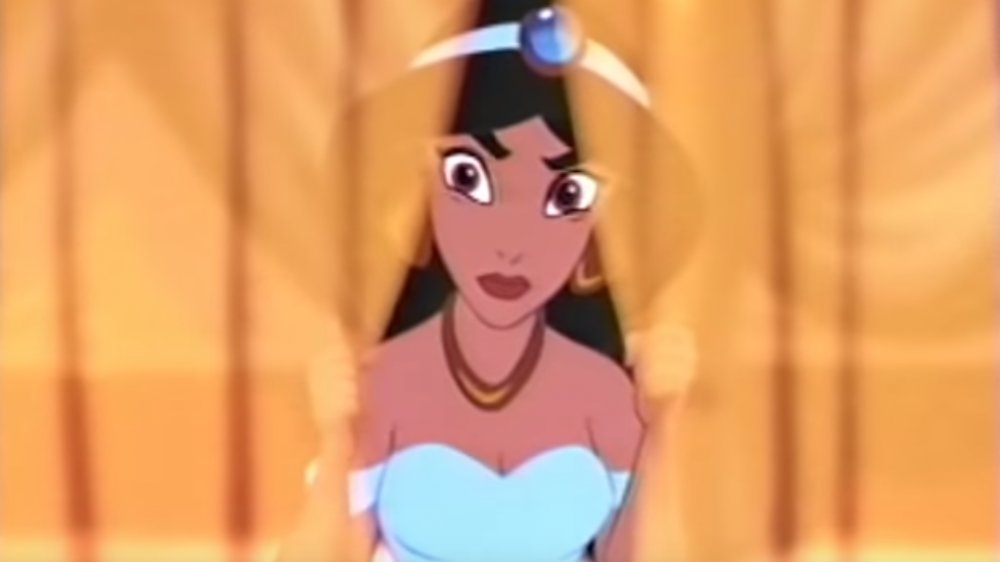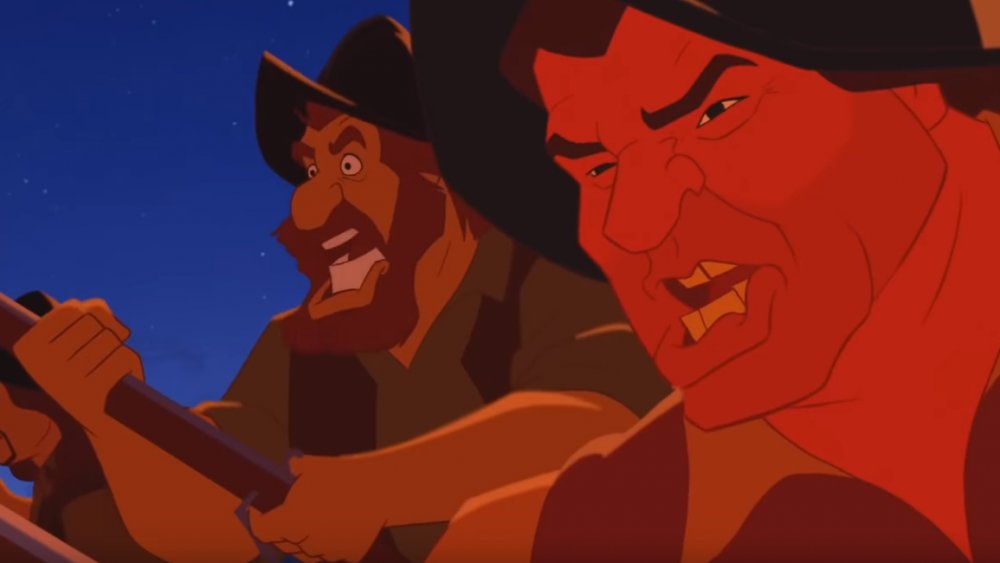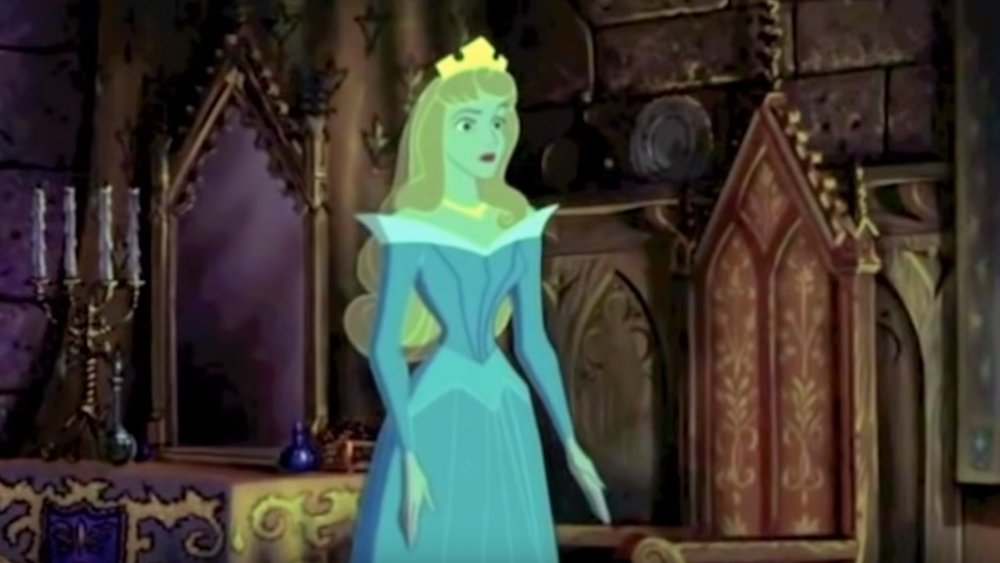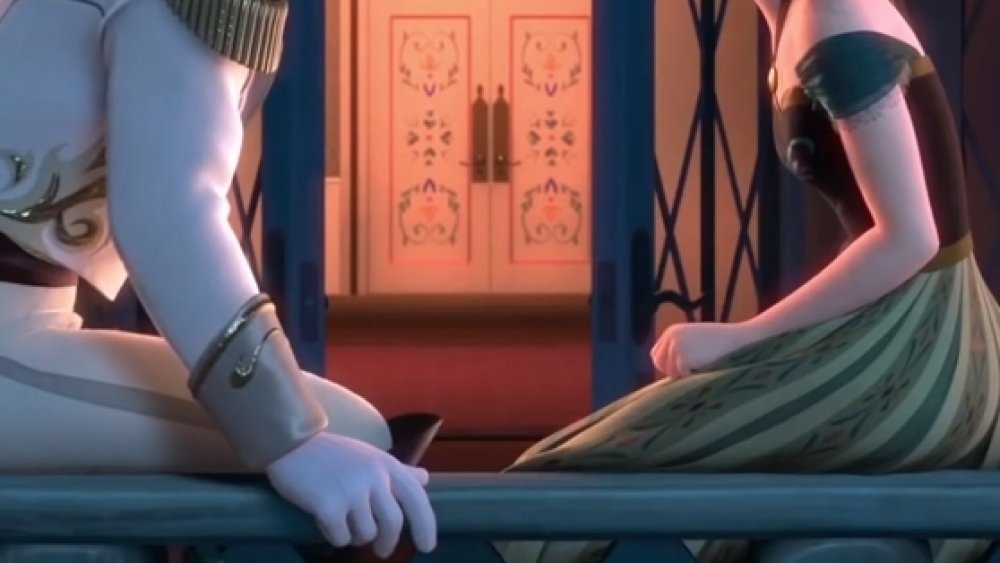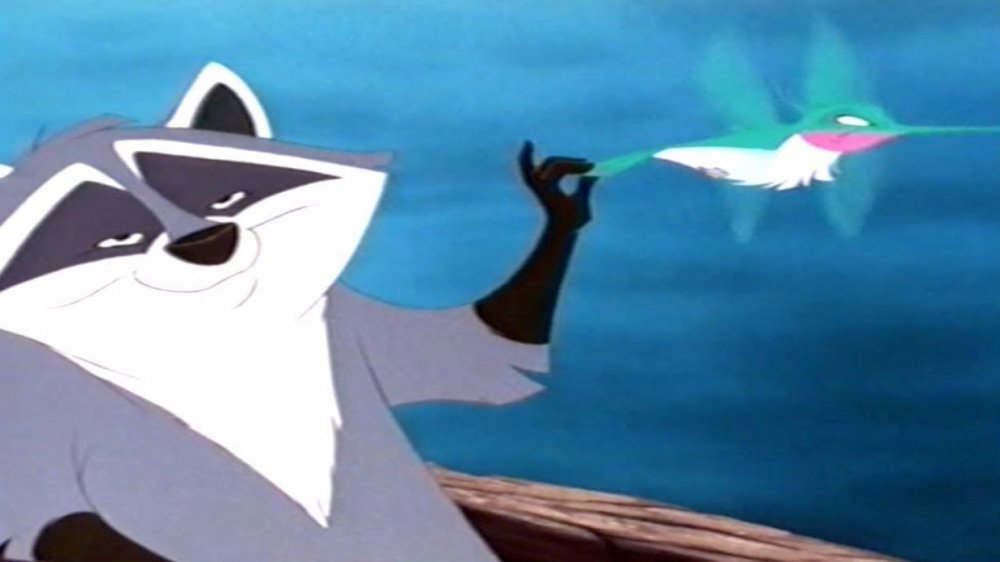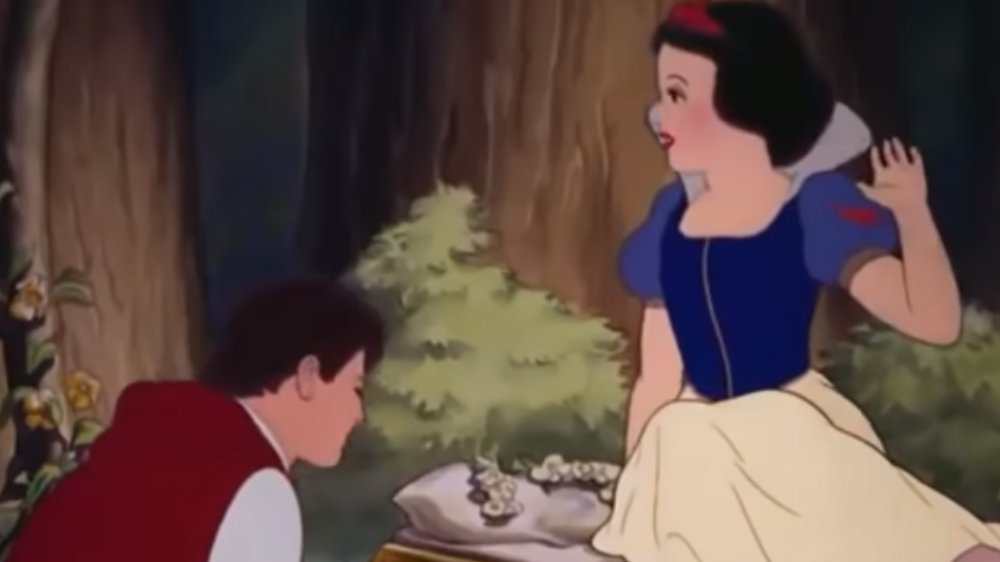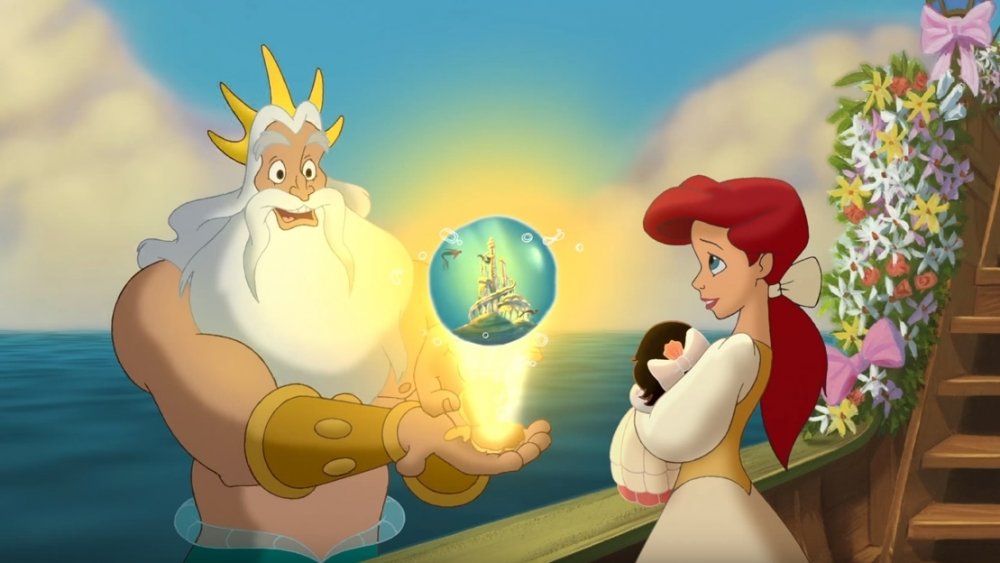Things Only Adults Notice In Disney Princess Movies
Of all Disney movies, few hold such a special place in the hearts of fans as the Disney princess films. And what's not to love? There's a princess to suit every personality, and one for pretty much every decade dating back to the '30s. Most of us grew up dressing like them for Halloween. Some of us still do. The point being, of course, that Disney's princess movies are seemingly timeless.
However, unless you have kids, it may have been a hot minute since you caught up with Snow White, Aurora, Jasmine, Pocahontas, Belle, Cinderella, Mulan, Ariel, Tiana, Rapunzel, Merida, Moana, and Elsa and Anna. But when you re-watch the oldies as an adult, you'll find that perhaps they aren't quite as copacetic as you remember.
From tragic pasts to some seriously subversive subliminal messaging, here are a few of the things you probably missed when you watched the Disney princess movies growing up.
There's no way the princesses would be so well-adjusted
Many of the princesses grew up in extreme isolation — let's consider this for a minute. Rapunzel obviously stands out, given she was quite literally locked away in a tower. Jasmine, Elsa and Anna spent their entire lives inside the palace gates. Aurora spent all her time with three eccentric old fairies. Cinderella, Mulan, and Snow White grew up under the thumb of oppressive family members, unfree to be themselves. As mentioned earlier, many also lost one or both parents when they were children.
And then there are all of the other traumatic things that happen to them. Kidnapping, attempted murder, dangerous voyages, arranged marriages, near-death experiences — the laundry list of bad fortune faced by Disney princesses goes on and on.
So, c'mon. In reality, these young women should be socially awkward at best. It's even totally plausible that some of them would have disorders or developmental issues from all the trauma they experienced during their early years of life. Yet, somehow, the princesses all magically get thrust into darkness and come out on the other side sparkly and bright. Grownup-you might not buy this as readily as un-jaded child-you.
There are Easter eggs aplenty
Pixar often gets all the credit for clever Easter eggs, but Disney manages to sneak a bunch into their princess movies, too. It makes sense kids wouldn't notice these for several reasons. Firstly, they may not have seen Disney's entire canon. Secondly, you need a keen eye to catch 'em.
In the opening scenes of The Little Mermaid when King Triton rides into the, uh, stadium (Amphitheater? Aqua-theater?), Mickey Mouse and friends are in the audience. When the Sultan in Aladdin stacks his toys, a beast figurine can be seen near the top. In The Princess and the Frog, a woman is shaking dust off what looks exactly like Jasmine and Aladdin's magic carpet off the side of her New Orleans balcony (above). The King and Grand Duke of Cinderella make a cameo as wedding guests in The Little Mermaid.
And if you really keep your eyes peeled when Flynn Rider takes Rapunzel to The Snuggly Duckling, you'll catch a glimpse of Pinocchio tucked into the bar's rafters. Who knows how many more there might be!
They're kinda pervy — or wait, maybe we are
It happens to the best of us. You're cruising along as kids, just living life with wide-eyed innocence, when an older cousin or sibling whispers a secret in our ear about male anatomy on King Triton's castle. Or, they tell us, if we re-watch the scene when Aladdin is on the balcony talking to Jasmine, we'll hear Genie whisper, "Good teenagers, take off your clothes."
Okay, so we concede that there are some conspiratorial subliminal messages that were apparently not actually intended to be there — but there are also outright innuendos. When Frozen's Anna and Kristoff argue over how well she knows Hans, he asks her Hans' foot size. To which Anna responds, "Foot size doesn't matter" — hello, bedroom humor! In Aladdin and the King of Thieves, what feels like an earthquake prompts Genie to quip, "I thought the Earth wasn't supposed to move until the honeymoon." Scandalous!
Even if you heard or saw these things when you were younger, you didn't know what they meant. Now ya do. Once you've been told about these things as an adult, it's hard to unsee (or hear) them. You're welcome.
Some of the songs are low-key terrifying
Have you ever really listened to "Savages" from Pocahontas? How about "Kill the Beast" from Beauty and the Beast? Yikes. This never registers to most of us when we're younger, but as an adult the lyrics really resonate as dark and twisted.
"Savages" relies entirely on fear-mongering and hate rhetoric regarding the Native American people: "What can you expect/from filthy little heathens?/Here's what you get when races are diverse/Their skin's a hellish red/They're only good when dead/They're vermin, as I said." Yowza.
In The Little Mermaid's "Poor Unfortunate Souls," Ursula sings about manipulating lonely, depressed people into giving up their souls. In Tangled's "Mother Knows Best," Mother Gothel convinces Rapunzel that she could be trampled by a rhino, mugged and left for dead, or attacked by men with pointy teeth in the outside world. Has anyone ever studied a link between an uptick in psychological counseling and kids who grew up watching Disney princesses?
What's a girl gotta do to get a curvy princess?
Disney princesses seem to be drawn up using the Barbie-body-measurement system. Tiny waists, enviably long legs, pert C-cups (guessing off-the-cuff here) — their figures are the idealized version of bodily perfection. Only, that's a crock, right? There's no such thing as the perfect anything, and females come in far more body shapes than Disney princesses represent.
The newer princesses, Merida and Moana, are arguably the only ones who embody a more realistic anatomy, though it certainly wouldn't hurt to see a more curvy women onscreen. Kids are still watching Disney movies all the way back to classics, and those older, outdated depictions of beauty could use a makeover. The very fact that young girls watching don't notice the lack of body diversity and instead internalize is all the more reason why change is necessary.
It's not as though a bit of updating would damage the legacy of Disney princess movies — it could only improve the public perception. Times have changed. People are more inclusive and socially conscious. It's time for the Disney princesses to hop on board, too. I mean, nobody complained about Merida and Moana, right? Because they're amazing.
Why do the men all have banana hands?
Seriously, the guys' hands are all so gigantic in comparison to the princesses and other female characters. Their fingers are so big, they look like a bunch of ripe bananas — this leaves us incredibly confused, and even a bit concerned.
Is this supposed to represent the strength of men versus the delicateness of women? Okay, so in real life, many men's hands are larger than their female counterparts. But if your partner's hands were to scale with these Disney dudes, he'd probably be in a medical lab somewhere being studied. It's amazing we didn't all grow up with super-bizarre body dysmorphia.
Given the Disney princess movies reputation for sexual innuendo, though, perhaps the guys' gigantic hands are supposed to be a mental trigger — ahem, you know what they say about men with big hands... it's not that they wear big gloves. Is this the banana-hands takeaway? God, let's hope not.
The movies wouldn't be the same without the anthropomorphic pets
Real talk — the pets are the best part. Can you imagine Jasmine without Rajah? Belle without Phillipe? Pocahontas without Flit and Meeko? In some of the princess movies, the animals actually talk (often because the princess lives in their world, such as The Little Mermaid and The Princess and the Frog). But even when the animals don't verbally speak, there is an implied communication with the princesses that is essential to character development.
Growing up, you probably liked the pets. As an adult, you love the pets. The blinders of youth are off, so you might find many of the main characters more annoying than you remember. All the things you didn't notice as a kid — how the princesses and princes can be selfish, irrational, etc. — jump out at you. Thus, the animals in the movies prove even more endearing.
These often-anthropomorphic pets don't get nearly enough credit for carrying the movies and supporting their humans through the plot.
Most of the princesses are super young
This could be the most frustrating realizations you experience when watching the Disney movies as an adult. The princesses are all so young! We don't necessarily know their exact ages in every case, although references can be found within some movies (Rapunzel's narrative centers on her 18th birthday). Still, it's clear the women are young. Their girlish features are one giveaway. However, what's most troubling is just how little life experience they've had. They're so naïve to the ways of the world. Most of them have never even met a boy, much less dated one before they fall in love and marry their prince.
That's not to say this sort of scenario never happens in real life. Some couples, like high school sweethearts, for instance, meet young and marry. Some of those couples even stay together. However, those people typically have a fairly normal existence prior to the point they meet. Disney princesses decidedly do not. You never realize the issues inherent with this until you watch when you're older, at which point you're like, where's the fire, ladies? You have your whole life to get hitched!
Only one Disney princess becomes a mom
It's Ariel! Of course, we don't find this out in the OG film — her daughter, Melody, is revealed in the sequel. But, so far, none of the other Disney princesses have gone on to have kids, as far as we know. It's interesting that kids don't notice this, because kids like to see other kids onscreen — ever notice that most of the Disney princess movies are essentially about teens or adults? You would think more Disney princess movies (or at least their sequels) would eventually incorporate a future generation.
It's also intriguing because it challenges the long-held tropes about a woman's roles. Since the Disney princess movies stretch back as far as the 1930s, many of them follow certain social mores: The women don't work, they like to bake, they dream of getting married. However, that pattern of thought has historically also included starting a family.
While it's actually kind of nice that the princesses don't rush into parenthood given how young they all appear to be, it does seem puzzling that only one ultimately has a little princess of her own.
